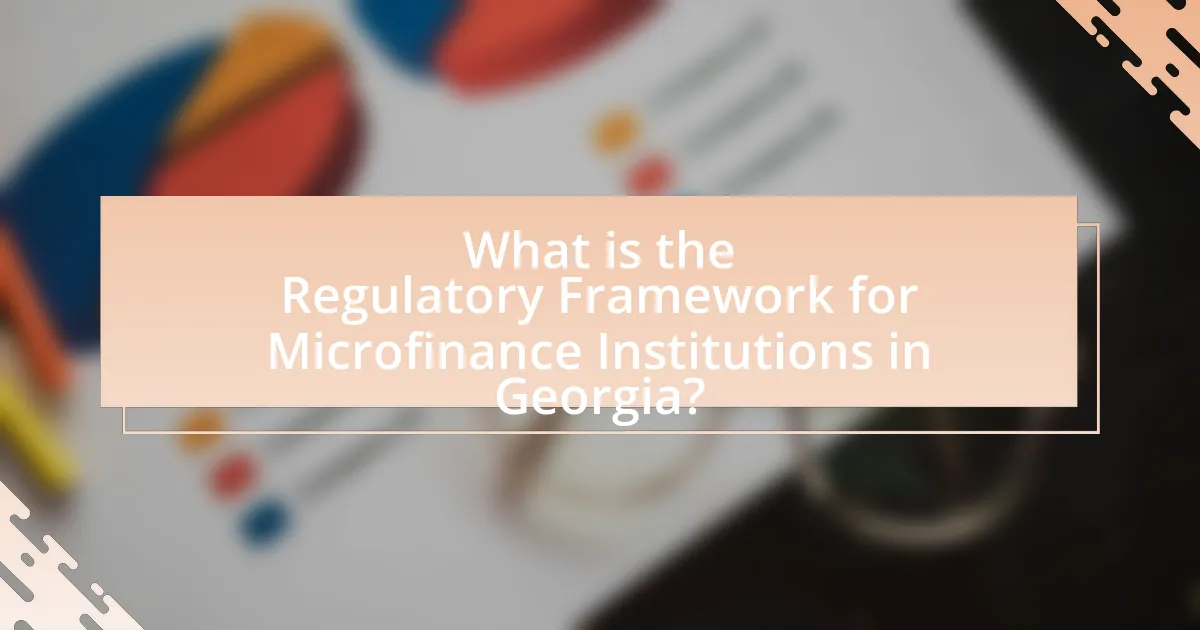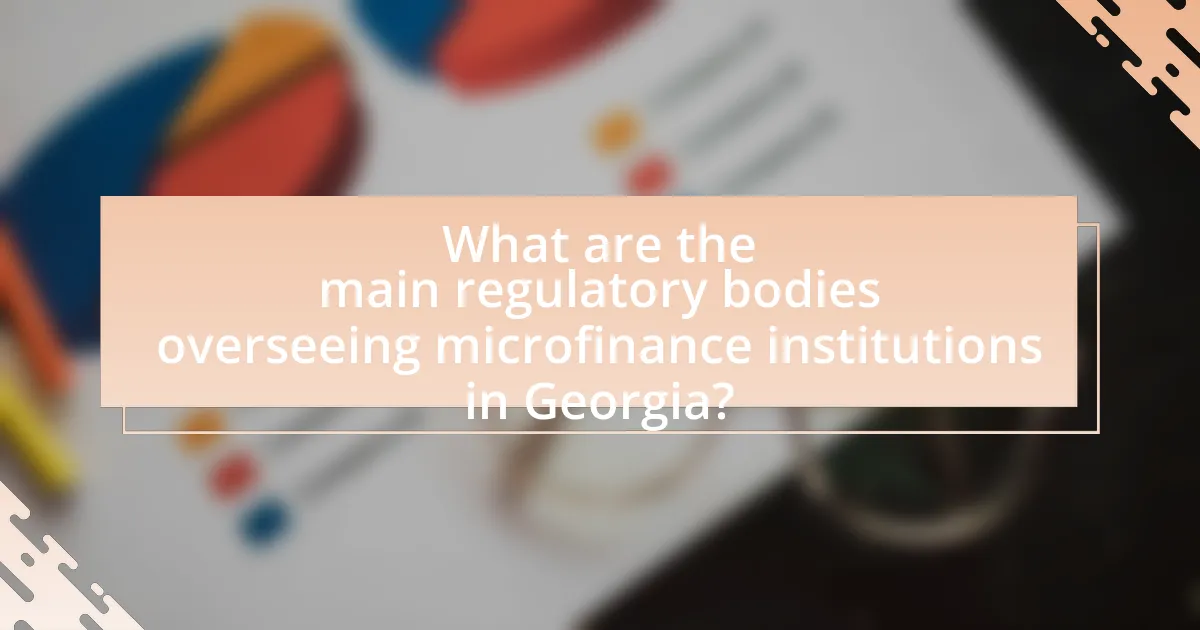The article focuses on the regulatory framework governing microfinance institutions in Georgia, primarily established by the Law on Microfinance Organizations enacted in 2006. It details the licensing requirements, operational standards, and consumer protection measures enforced by the National Bank of Georgia, which oversees compliance and financial stability. Key components of the framework include capital adequacy standards, reporting obligations, and guidelines for responsible lending practices. The article also highlights the importance of regulatory bodies in ensuring transparency, protecting consumers, and mitigating risks within the microfinance sector, as well as the specific regulations that microfinance institutions must follow to operate legally and sustainably.

What is the Regulatory Framework for Microfinance Institutions in Georgia?
The regulatory framework for microfinance institutions in Georgia is primarily governed by the Law on Microfinance Organizations, enacted in 2006, which establishes the legal basis for their operation. This law outlines the licensing requirements, operational standards, and consumer protection measures that microfinance institutions must adhere to. Additionally, the National Bank of Georgia oversees the regulation and supervision of these institutions, ensuring compliance with financial stability and transparency standards. The framework aims to promote financial inclusion while safeguarding the interests of borrowers, as evidenced by the implementation of interest rate caps and mandatory reporting requirements.
How is the regulatory framework defined in Georgia?
The regulatory framework in Georgia is defined by a combination of laws, regulations, and supervisory practices that govern financial institutions, including microfinance organizations. This framework is primarily established by the National Bank of Georgia, which oversees the licensing, operation, and compliance of microfinance institutions to ensure financial stability and consumer protection. The Law on Microfinance Organizations, enacted in 2016, specifically outlines the requirements for registration, capital adequacy, and reporting standards, thereby providing a structured approach to regulation. Additionally, the framework is supported by international standards and best practices, which Georgia has adopted to enhance its financial sector’s integrity and efficiency.
What are the key components of this regulatory framework?
The key components of the regulatory framework for microfinance institutions in Georgia include licensing requirements, capital adequacy standards, consumer protection regulations, and reporting obligations. Licensing requirements ensure that only qualified entities operate as microfinance institutions, while capital adequacy standards mandate a minimum level of capital to safeguard against financial risks. Consumer protection regulations are designed to prevent predatory lending practices and ensure transparency in loan terms. Reporting obligations require institutions to submit regular financial statements and operational data to regulatory authorities, promoting accountability and oversight. These components collectively aim to foster a stable and transparent microfinance sector in Georgia.
How does the framework ensure compliance among microfinance institutions?
The framework ensures compliance among microfinance institutions in Georgia through a combination of regulatory oversight, licensing requirements, and regular audits. Regulatory bodies, such as the National Bank of Georgia, enforce compliance by requiring microfinance institutions to adhere to specific operational standards and financial reporting guidelines. These institutions must obtain licenses that are contingent upon meeting capital adequacy ratios and maintaining transparency in their lending practices. Regular audits conducted by the regulatory authority further verify adherence to these standards, ensuring that institutions operate within the legal framework and protect consumer interests.
Why is the regulatory framework important for microfinance institutions?
The regulatory framework is important for microfinance institutions because it ensures financial stability, consumer protection, and operational transparency. A well-defined regulatory environment helps mitigate risks associated with lending practices, thereby fostering trust among clients and investors. For instance, regulations can limit interest rates and enforce fair lending practices, which protect borrowers from exploitation. Additionally, compliance with regulatory standards can enhance the credibility of microfinance institutions, attracting more funding and enabling them to serve a larger client base effectively.
What risks does the framework mitigate for microfinance institutions?
The framework mitigates several risks for microfinance institutions, including credit risk, operational risk, and regulatory compliance risk. By establishing clear guidelines and standards, the framework ensures that microfinance institutions assess borrowers’ creditworthiness effectively, reducing the likelihood of defaults. Additionally, it provides operational protocols that enhance efficiency and reduce the potential for fraud or mismanagement. Furthermore, the framework enforces compliance with local regulations, minimizing the risk of legal penalties and fostering a stable operating environment. These measures collectively contribute to the sustainability and resilience of microfinance institutions in Georgia.
How does the framework protect consumers in Georgia?
The framework protects consumers in Georgia by establishing regulations that ensure transparency, fair lending practices, and consumer rights. Specifically, the National Bank of Georgia oversees microfinance institutions, requiring them to disclose all terms and conditions of loans clearly, which helps consumers make informed decisions. Additionally, the framework mandates that interest rates and fees be reasonable and prohibits predatory lending practices, thereby safeguarding consumers from excessive debt. These measures are supported by the Consumer Protection Law, which provides avenues for consumers to file complaints and seek redress, reinforcing their rights within the financial system.

What are the main regulatory bodies overseeing microfinance institutions in Georgia?
The main regulatory bodies overseeing microfinance institutions in Georgia are the National Bank of Georgia (NBG) and the Ministry of Finance. The NBG is responsible for the licensing, regulation, and supervision of microfinance institutions, ensuring compliance with financial laws and regulations. The Ministry of Finance plays a role in the broader financial policy framework, impacting the operational environment for microfinance institutions. These bodies work together to maintain financial stability and protect consumers in the microfinance sector.
What roles do these regulatory bodies play?
Regulatory bodies play a crucial role in overseeing microfinance institutions in Georgia by ensuring compliance with laws and regulations. They establish guidelines that govern the operations of these institutions, promote transparency, and protect consumers from unfair practices. For instance, the National Bank of Georgia regulates microfinance activities to maintain financial stability and safeguard depositors’ interests. This regulatory framework is essential for fostering a trustworthy financial environment, which is supported by the fact that effective regulation can lead to increased public confidence in microfinance services.
How do these bodies enforce regulations on microfinance institutions?
Regulatory bodies enforce regulations on microfinance institutions in Georgia through a combination of licensing, supervision, and compliance monitoring. These entities, such as the National Bank of Georgia, require microfinance institutions to obtain licenses to operate, ensuring they meet specific financial and operational standards. Regular audits and inspections are conducted to assess adherence to regulations, including capital adequacy and consumer protection laws. Additionally, these bodies impose penalties for non-compliance, which can include fines or revocation of licenses, thereby maintaining the integrity of the microfinance sector.
What are the reporting requirements for microfinance institutions?
Microfinance institutions in Georgia are required to submit regular financial and operational reports to the National Bank of Georgia. These reports typically include balance sheets, income statements, and details on loan portfolios, which must be submitted quarterly and annually. The National Bank of Georgia mandates these reporting requirements to ensure transparency, monitor financial health, and assess compliance with regulatory standards. Compliance with these requirements is crucial for maintaining operational licenses and fostering trust among stakeholders.
How do these regulatory bodies interact with microfinance institutions?
Regulatory bodies interact with microfinance institutions in Georgia by establishing guidelines, monitoring compliance, and ensuring consumer protection. These bodies, such as the National Bank of Georgia, set regulatory frameworks that dictate operational standards, licensing requirements, and capital adequacy ratios for microfinance institutions. For instance, the National Bank of Georgia has implemented specific regulations that require microfinance institutions to maintain a minimum capital threshold and adhere to responsible lending practices, thereby promoting financial stability and protecting borrowers. This interaction is crucial for fostering a transparent and accountable microfinance sector, which is essential for economic development in Georgia.
What support do regulatory bodies provide to microfinance institutions?
Regulatory bodies provide essential support to microfinance institutions by establishing a legal framework that ensures compliance, stability, and consumer protection. This support includes licensing, supervision, and the creation of guidelines that govern lending practices, which help maintain the integrity of the microfinance sector. For instance, in Georgia, the National Bank of Georgia regulates microfinance institutions, ensuring they adhere to prudential standards and risk management practices, thereby fostering a stable financial environment. Additionally, regulatory bodies often facilitate access to funding and resources, enhancing the operational capacity of microfinance institutions.
How do microfinance institutions engage with regulatory bodies?
Microfinance institutions engage with regulatory bodies by adhering to established guidelines and regulations that govern their operations. These institutions regularly submit reports and data to regulatory authorities, ensuring compliance with financial standards and consumer protection laws. For instance, in Georgia, microfinance institutions must register with the National Bank of Georgia and follow its directives, which include maintaining capital adequacy ratios and conducting regular audits. This engagement fosters transparency and accountability, essential for maintaining trust and stability in the financial system.

What are the specific regulations affecting microfinance institutions in Georgia?
Microfinance institutions in Georgia are primarily regulated by the National Bank of Georgia (NBG) under the Law on Microfinance Organizations, which was enacted in 2016. This law establishes licensing requirements, capital adequacy standards, and consumer protection measures for microfinance institutions. Additionally, the NBG mandates that these institutions adhere to responsible lending practices, including transparency in interest rates and fees, as well as the provision of clear information to borrowers. The regulatory framework aims to ensure financial stability and protect consumers, reflecting the NBG’s commitment to fostering a safe microfinance environment.
What licensing requirements must microfinance institutions meet?
Microfinance institutions in Georgia must obtain a license from the National Bank of Georgia to operate legally. This licensing process requires institutions to meet specific capital adequacy requirements, demonstrate sound governance structures, and adhere to consumer protection regulations. Additionally, applicants must provide detailed business plans and financial projections to ensure sustainability and compliance with regulatory standards. The National Bank of Georgia enforces these requirements to promote financial stability and protect consumers in the microfinance sector.
What are the steps to obtain a license for a microfinance institution?
To obtain a license for a microfinance institution in Georgia, the following steps must be followed: First, the applicant must prepare a comprehensive business plan that outlines the institution’s objectives, target market, and financial projections. Next, the applicant submits the business plan along with required documentation, including proof of capital adequacy and the qualifications of management personnel, to the National Bank of Georgia. The National Bank then conducts a thorough review of the application, assessing compliance with regulatory requirements. If the application meets all criteria, the National Bank issues a license, allowing the institution to operate legally. This process is governed by the Law of Georgia on Microfinance Organizations, which establishes the regulatory framework for such institutions.
What are the consequences of operating without a license?
Operating without a license can lead to severe legal consequences, including fines, penalties, and potential criminal charges. In Georgia, microfinance institutions must adhere to regulatory requirements set by the National Bank of Georgia; failure to comply can result in the suspension of operations and legal action. For instance, unlicensed entities may face fines that can reach up to 10,000 GEL, as stipulated in the Law of Georgia on Microfinance Organizations. Additionally, operating without a license undermines consumer trust and can lead to reputational damage, further complicating future business endeavors.
What operational regulations must microfinance institutions follow?
Microfinance institutions in Georgia must adhere to specific operational regulations established by the National Bank of Georgia. These regulations include licensing requirements, capital adequacy standards, and consumer protection measures. For instance, microfinance institutions are required to maintain a minimum capital threshold to ensure financial stability and are subject to regular audits to verify compliance with financial reporting standards. Additionally, they must implement transparent lending practices and provide clear information regarding interest rates and fees to protect consumers. These regulations are designed to promote responsible lending and safeguard the interests of borrowers, thereby fostering a stable microfinance sector in Georgia.
How do interest rate caps affect microfinance operations?
Interest rate caps limit the maximum interest rates that microfinance institutions (MFIs) can charge borrowers, directly impacting their operational sustainability and profitability. When interest rates are capped, MFIs may struggle to cover their costs, particularly in regions where operational expenses are high and default rates are significant. For instance, a study by the Consultative Group to Assist the Poor (CGAP) found that in countries with strict interest rate caps, MFIs often face financial constraints, leading to reduced lending capacity and limited product offerings. This can ultimately hinder their ability to serve low-income clients effectively, as they may become less willing to lend or may increase fees for other services to compensate for lost revenue.
What are the guidelines for responsible lending practices?
Responsible lending practices are guided by principles that ensure borrowers can repay loans without undue hardship. These guidelines include assessing the borrower’s ability to repay, providing clear and transparent information about loan terms, and avoiding predatory lending practices. For instance, the European Union’s Consumer Credit Directive emphasizes the importance of affordability assessments to prevent over-indebtedness. Additionally, responsible lenders should offer financial education to borrowers, helping them understand the implications of borrowing. These practices are essential in promoting sustainable lending and protecting consumers within the regulatory framework for microfinance institutions in Georgia.
What are the reporting and compliance obligations for microfinance institutions?
Microfinance institutions in Georgia are required to adhere to specific reporting and compliance obligations set forth by regulatory authorities. These obligations include submitting regular financial statements, maintaining accurate records of transactions, and ensuring compliance with anti-money laundering (AML) and know-your-customer (KYC) regulations. Additionally, microfinance institutions must report on their loan portfolios, interest rates, and client demographics to the National Bank of Georgia, which oversees the sector to promote transparency and protect consumers. Compliance with these regulations is essential for maintaining operational licenses and fostering trust within the financial system.
How often must microfinance institutions report to regulatory bodies?
Microfinance institutions in Georgia must report to regulatory bodies on a quarterly basis. This requirement is established by the National Bank of Georgia, which mandates that these institutions submit financial statements and other relevant data every three months to ensure compliance with regulatory standards and to maintain transparency in their operations.
What information is required in compliance reports?
Compliance reports for microfinance institutions in Georgia require specific information to ensure adherence to regulatory standards. This information typically includes details on financial performance, risk management practices, compliance with lending regulations, and customer protection measures. Additionally, reports must document internal controls, governance structures, and any incidents of non-compliance along with corrective actions taken. These elements are essential for demonstrating accountability and transparency, which are critical in the regulatory framework governing microfinance institutions.
What best practices should microfinance institutions adopt to comply with regulations?
Microfinance institutions should adopt comprehensive compliance programs to adhere to regulations effectively. These programs must include regular training for staff on regulatory requirements, ensuring that all employees understand the legal framework governing microfinance operations. Additionally, institutions should implement robust internal controls and risk management systems to monitor compliance continuously.
Regular audits and assessments of compliance practices are essential, as they help identify gaps and areas for improvement. Furthermore, maintaining transparent communication with regulatory bodies fosters trust and ensures that institutions stay updated on any changes in regulations. According to the National Bank of Georgia, adherence to these practices not only mitigates risks but also enhances the institution’s reputation and operational sustainability.
How can microfinance institutions stay updated on regulatory changes?
Microfinance institutions can stay updated on regulatory changes by actively engaging with regulatory bodies and industry associations. These institutions should subscribe to newsletters and alerts from the National Bank of Georgia, which oversees financial regulations, and participate in workshops and seminars organized by the Georgian Microfinance Association. Additionally, they can utilize online platforms that aggregate regulatory updates and maintain a dedicated compliance team to monitor changes in legislation. This approach ensures that microfinance institutions remain informed about the evolving regulatory landscape, which is crucial for compliance and operational effectiveness.
What resources are available for microfinance institutions to ensure compliance?
Microfinance institutions in Georgia can utilize several resources to ensure compliance with regulatory frameworks. These resources include guidelines provided by the National Bank of Georgia, which outlines the legal requirements and best practices for microfinance operations. Additionally, institutions can access training programs and workshops offered by organizations such as the Microfinance Centre, which focus on compliance and risk management. Furthermore, consulting firms specializing in financial regulations can provide tailored advice and support to help institutions navigate compliance challenges effectively. These resources collectively enhance the ability of microfinance institutions to adhere to regulatory standards and mitigate risks associated with non-compliance.